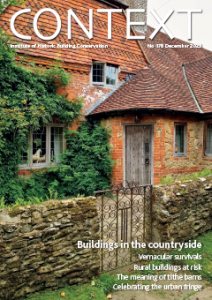 The new issue of the IHBC’s members’ journal, Context No. 178, explores Buildings in the countryside alongside much more, including regular features and special insights to bridge listing, reversibility, and Zen.
The new issue of the IHBC’s members’ journal, Context No. 178, explores Buildings in the countryside alongside much more, including regular features and special insights to bridge listing, reversibility, and Zen.
… the ordinary (rather than monumental)…
The IHBC writes:
Context is the flag we fly under; in this issue the context is rural. The pace of change is slower in the countryside, and the influence of the natural landscape more dominant than in towns and cities. The slower pace of change leaves a greater proportion of vernacular buildings intact, and confronts us with difficult issues of how to conserve them for viable new uses.
By ‘vernacular’ we mean, not the selected supposedly local materials or styles that developers often adopt on the advice of their marketing departments or the council’s planners, but the ordinary (rather than monumental) buildings that were built in a particular place before local styles, techniques and materials were superseded by imports. This is the opposite of ‘polite’ architecture (though many historic buildings have both vernacular and polite elements). A vernacular building reflects the conditions of its time; the availability of construction materials; the cost of transporting and processing them; and the traditions and availability of craft skills.
In particular we focus in this issue of Context on farm buildings; on tithe barns, those often unchanged cathedrals of the vernacular; on buildings with timber frames, whose treatment depends on getting the process right; on a Devon fishing village whose houses need to be adapted to, among other things, using energy more efficiently; and on the urban (or rural) fringe, where town and country meet, and whose many surprising juxtapositions are celebrated by some people with the imagination to appreciate the fringe’s sense of place, and its potential to evolve into something yet richer.
Conserving individual rural buildings raises the usual questions of how to accommodate new uses, innovative technologies and modern priorities, such as the need to combat climate change. It also leads us to wider questions. A significant proportion of future development – for housing in balanced communities, among much else – will be in places other than in or next to existing towns and cities. Extending or infilling villages and building new settlements in the countryside will depend, if it is to be done successfully, on understanding historic patterns of building.
Why did they build like that here, with those materials, techniques, layouts and responses to the typography? And what can we learn from them that will allow us to build in ways that will be environmentally sensitive, locally distinctive and resource-efficient?
Themed articles include:
- Understanding vernacular architecture
- Alexandra Fairclough
- Rural buildings at risk Jonathan Thompson
- Fringe benefits Michael Taylor
- The meaning of tithe barns Anthea Jones
- Surveying vernacular roofs Terry Hughes
- Deciding on treatment for a timber frame, Joe Thompson
- Power houses, Ben Cowell
- Sustaining a rural village, Dan Rigamonti
Feature articles include:
- Reversibility in conservation ethics Alfie Robinson
- A listed bridge too far Douglas Campbell
- Zen and the art of cycling exploration Ian Wray
Regular features include:
- Briefing
- Periodically
- Legal update
- New members
- New member profile
- Notes from the chair
- Inter alia
- Director’s cut
- Vox pop
- Book reviews
- Products and services
- Specialist suppliers index
Reading Context helps IHBC members develop their skills across all of the IHBC’s Areas of Competence, and so is a critical baseline in addressing priorities in Continuing Professional Development (CPD)
Access the online archive and see the issue online
See more IHBC background and guidance on IHBC CPD and on how you might use past, current and future issues of Context
See the formal guidance paper on IHBC CPD (scheduled for update)
See more on the IHBC Competences and Areas of Competence

